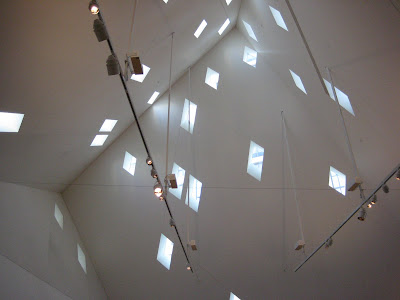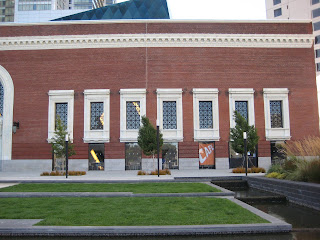This week we focused again on our vignettes, which will eventually be pieced together to create a map of our building.
We are expected to be able to tell why we think certain things about our building, for example if we think the building is ugly we have to be able to explain "why?". The book
Experiencing Architecture helps us to relate to buildings of the past by giving us examples of inspiration from the past which have helped redefine or create new structures.
Solids and cavities: a doorway can lend a feeling of being in a cavity; you cannot create cavity (hollow, void, shadow, enclosed/ cave -> rock, cavernous -> echo) without the solid aspect; similarly, we must understand disorganization to understand organization; solid/void; figure/ground.
History: exploration of people and culture, how they live, what their values are, their technology; how these things have changed over time --> ultimately, how can we create architecture that fits into the lives of specific peoples' needs? As history changes, so does art and architecture --> it's a process/ it's progressive; grandeur of scale changes with peoples' needs (classical structures were built for the gods, and today's houses have shrunk - absence of God?).
In today's society, structures are scaleless:
THEN (classical): scale, proportion; gods, nature (untamed); grandeur, mass; fear, power, awe; stage; math, organization, golden section; beauty, perfection; sculptural (reaching to the heavens)
B/N THEN & NOW(gothic): structure, organization, columns; sculpture; technology, light (a different kind of reverence - reaching to the "heavens")
NOW (mannerist): scaleless; ornamentation (technology, steel, glass); digital design; rules, godless, chaotic, monotonous; skyscrapers (reaching for the heavens in a secular way)
Are we back to Gothic? --> intimate space, divine beauty, individualism (we don't use our bodies as scales anymore - as Le Corbusier did), technology, movement of space
- the word support can make us envision different things such as legs or bones (physical) or we might think of emotional support
- Daniel Libeskind's work is appealing/ successful because he deals with things in the emotional realm ("support"); his lines are a conscious effort to tell a story; his lines are based on symbolism
- modernism - "palate cleansing" --> clean?
- form follows function
- why paint brick? - paint can take away from the honesty of a material
- Le Corbusier - started to create Modernism; connected to nature (what you take, you put back)
- technology is allowing us to be disorganized
- if you can draw "beautiful", how can you draw "unbeautiful"?

















































